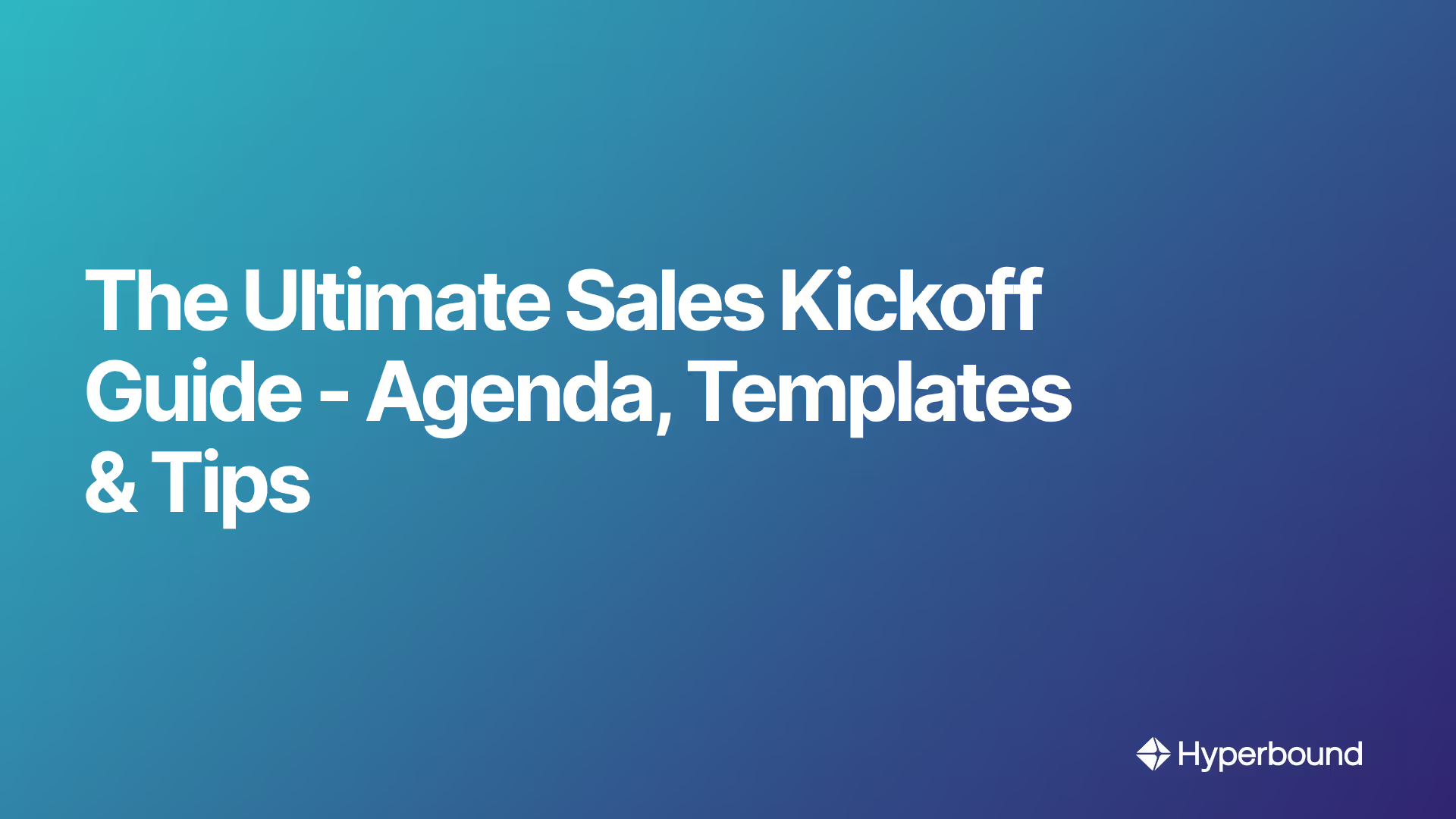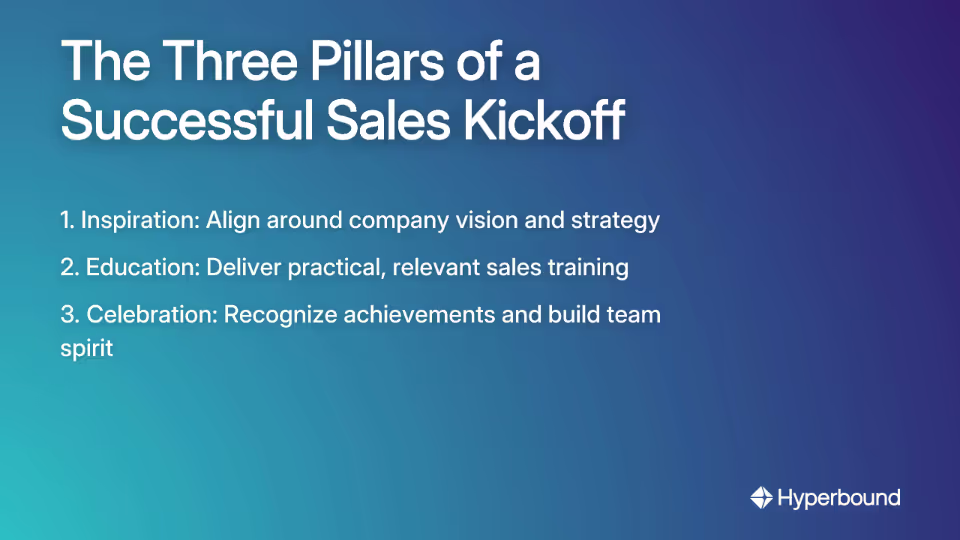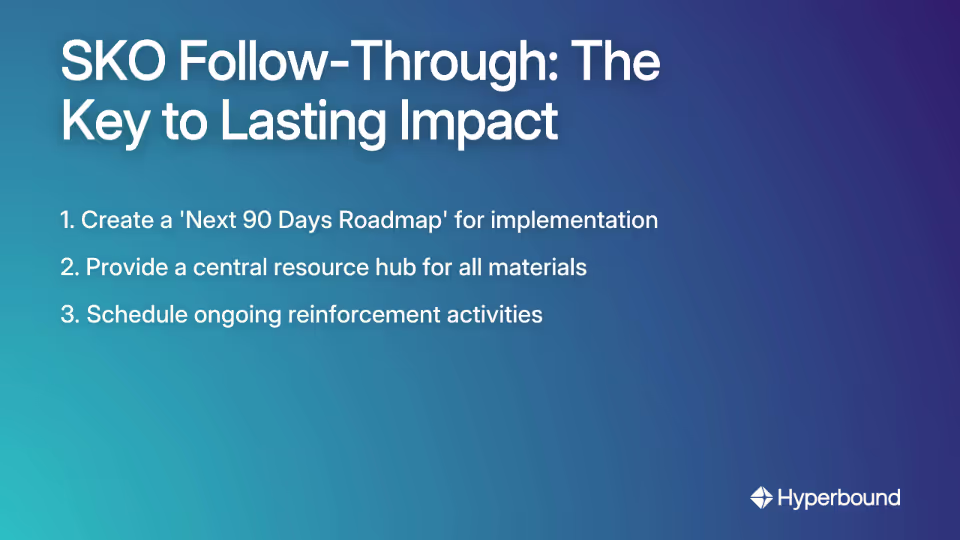
You've just received the email: "Save the date for our annual Sales Kickoff!" For some, this triggers excitement about reconnecting with colleagues. For others, it prompts dread about enduring what one sales rep described as "death by a million cringes."
Whether you're planning the event or just attending, this guide will help you navigate the world of Sales Kickoffs (SKOs) to ensure they deliver actual value rather than becoming another corporate "boondoggle" where you're forced to "drink the kool-aid."
What is a Sales Kickoff (And Why It's More Than a Meeting)
A Sales Kickoff is the annual gathering of a company's sales organization to celebrate past wins, align on strategy, and prepare for the upcoming year. Think of it as the sales team's "Super Bowl" – a high-energy event designed to set the tone for success.
According to research from the Opus Agency, 85% of companies fail to maximize the impact of their sales kickoff meetings, often due to information overload or a lack of meaningful engagement. This failure rate isn't surprising when you consider the common complaints from salespeople about "cringey" activities and excessive corporate enthusiasm.
Every successful SKO is built on three core pillars:

- Inspiration: Aligning the team around company goals, vision, and strategic direction through compelling keynotes and interactive sessions.
- Education: Delivering practical, relevant training tailored to reps' needs. For example, implementing David Sandler training or MEDDIC/MEDDPICC for opportunity qualification that helps solve real-world problems like ghosted prospects.
- Celebration: Recognizing achievements and fostering team spirit through awards and activities that build genuine camaraderie.
The Psychology of an Unforgettable SKO
The most effective SKOs are designed with human behavior in mind:
- Peak-End Rule: People judge an experience based on how they felt at its most intense point (the peak) and at its end. This means you need to engineer memorable high points and ensure the event concludes on a powerful, positive note.
- Social Learning Theory: Interactive, peer-led sessions are far more effective than traditional lectures. As one sales rep put it: "The only training that was worth a damn was actually doing the job and falling on my face." Facilitate this by turning top performers into coaches and using real-world scenario workshops.
- Goal-Setting Theory: Research shows performance improves when goals are specific and challenging. The SKO is the perfect forum to transparently set annual sales goals and outline tactics to achieve them.
The Ultimate SKO Planning Framework (Before, During, and After)
Phase 1: Before the Event
- Define Clear Objectives: Align your SKO goals with broader company objectives. Ask yourself: "What should salespeople be able to do differently after this event?"
- Assemble a Cross-Functional Planning Team: Include members from marketing, product, customer success, and HR for comprehensive content and smoother execution.
- Gather Rep Feedback: Survey your sales team about their challenges and what they want to learn. This ensures relevance and prevents the dreaded feeling of a useless event.
- Assign Light Pre-Work: To avoid information overload during the event, assign foundational pre-work such as watching a specific TED Talk or submitting personal SKO goals.
Phase 2: During the Event
- Use the 30-30-30 Rule: Structure sessions into 30 minutes of content, 30 minutes of practice, and 30 minutes of discussion to keep engagement high.
- Implement Engaging Formats:
- Peer Teaching & "Success Circles": Let top performers share winning strategies
- Live Practice & Role-Plays: Use tools like Hyperbound's AI Sales Roleplays to run scalable, real-world scenarios where reps can practice handling objections or asking for the sale in a safe, repeatable environment.
- Customer Panels: Bring in actual customers to provide invaluable insights into their buying process
- For Hybrid/Virtual SKOs: Keep virtual sessions short, use interactive tools like polls and digital breakout rooms, and actively call on attendees to combat Zoom fatigue.

Phase 3: After the Event
The biggest mistake companies make is missing follow-through. An SKO fails if the learning isn't reinforced:

- Create a "Next 90 Days Roadmap": Give every attendee an actionable plan for implementing what they've learned in the next quarter.
- Provide a Central Resource Hub: Use a sales enablement or coaching platform like Hyperbound, Seismic, or Highspot to host recordings, slides, and follow-up materials.
- Schedule Ongoing Reinforcement: Go beyond simple quizzes. To ensure new skills are retained and applied, leverage AI coaching platforms for continuous practice roleplays and automated feedback on real calls.
Sample SKO Agenda & Inspiring Ideas (Templates You Can Steal)
Sample 2-Day Agenda:
Day 1: Vision & Strategy
- Morning: Welcome Breakfast, Executive Keynote, Sales Strategy Presentation
- Afternoon: Interactive Workshop (e.g., MEDDIC opportunity qualification), Customer Panel, Roundtable Discussions
- Evening: Team-Building Activity, Dinner & Leaderboard Recognition
Day 2: Skills & Celebration
- Morning: Product Presentations, Peer-Led "Success Circles" on topics like upfront contracts and closing techniques
- Afternoon: External Keynote Speaker, Team Challenge, Awards Ceremony & Wrap-Up
Team-Building Ideas That Don't Suck
Addressing the common sentiment that "team building exercises kind of suck," here are activities that foster connection without the cringe:
- "Rock, Paper, Scissors Extreme": A high-energy, low-stakes tournament that gets people laughing
- "Shark Tank Fail": Teams pitch their worst ideas for laughs
- Optional Volunteer Opportunities: Give back to the community together without forced participation
- Casual Happy Hours: Sometimes "less bullshit more open conversation and booze" is exactly what's needed
10 Inspiring SKO Themes for Your Sales Kickoff Presentation:
- Ignite the Future
- Together We Rise
- Unleash Your Potential
- Winning Mindset
- Customer-Centric Revolution
- Data-Driven Success
- The Art of Storytelling
- Navigating Change
- Sustainability in Sales
- Trailblazers: Pioneering New Paths
A Practical Guide for Attendees (How to Survive and Thrive at Your Next SKO)
What to Wear
Wondering about the dress code? Business casual is generally a safe bet. As one experienced sales professional advises: "Grab a comfortable blazer, wear it over almost anything and you'll probably fit in." When in doubt, it's better to be slightly overdressed than underdressed.
How to Network Effectively
Don't just hang out with people you already know. "Use the opportunity to network. Meet as many people as you can, sales leaders, product managers, senior leadership." If you're unsure where to start, "ask your new boss and a new teammate" for introductions.
Professional Conduct
Remember that while SKOs often include social activities, they're still professional events. "Pace yourself and remember that no one remembers if you are the first person to leave the bar." Avoid behavior that might damage your reputation – there are numerous stories of careers derailed by poor judgment at company events.
Your Sales Kickoff Checklist for Success
Whether you're planning or attending, use this Sales Kickoff Checklist to ensure you're prepared:
For Planners:
☐ Define clear objectives aligned with company goals
☐ Survey sales team for input on content and format
☐ Create a balanced agenda across the three pillars (Inspiration, Education, Celebration)
☐ Prepare pre-work materials and distribute in advance
☐ Arrange for recording key sessions for later reference
☐ Develop a 90-day follow-up plan for reinforcement
For Attendees:
☐ Complete any assigned pre-work
☐ Bring business cards and prepare a brief personal introduction
☐ Pack appropriate attire (business casual with options to dress up)
☐ Set personal goals for what you want to learn and who you want to meet
☐ Prepare questions for leadership and subject matter experts
☐ Schedule time after the SKO to implement key learnings
Conclusion
A great SKO is a strategic blend of inspiration, education, and celebration. It requires meticulous planning and an approach rooted in psychological principles like the Peak-End Rule.
By focusing on authenticity, peer-to-peer learning, and actionable takeaways, you can transform your SKO from a dreaded obligation into the most valuable event of the year. Whether you're planning the next sales kickoff presentation or attending as a participant, these strategies will help you maximize the experience and drive real results.

Remember, the ultimate measure of an SKO's success isn't the event itself, but the impact it has on sales performance in the months that follow. Make every minute count!
Frequently Asked Questions
What is a Sales Kickoff?
A Sales Kickoff (SKO) is an annual event for a company's sales team designed to celebrate past achievements, align on future strategy, and prepare for the upcoming year. It's more than just a meeting; it's a strategic event built on the three pillars of inspiration (aligning on vision), education (providing practical training), and celebration (recognizing success and building camaraderie).
How can you make a Sales Kickoff engaging and not "cringey"?
To make an SKO engaging, focus on interactive and peer-led sessions rather than one-way lectures. Implement formats like peer teaching, "Success Circles," customer panels, and scalable role-plays. Activities should foster genuine connection without feeling forced, such as a high-energy "Rock, Paper, Scissors Extreme" tournament or casual networking events.
What is the most common mistake in SKO planning?
The most common mistake is a lack of follow-through after the event ends. Many companies fail to reinforce the learnings from the SKO, causing the initial momentum and knowledge to fade. To avoid this, create a "Next 90 Days Roadmap" for implementation, provide a central hub for all materials, and schedule ongoing reinforcement activities like continuous coaching and practice.
How long should a Sales Kickoff last?
A typical Sales Kickoff lasts between one to three days, with a two-day agenda being a popular and effective format. This allows enough time to cover the core pillars: Day 1 can focus on vision and strategy, while Day 2 can be dedicated to skills training and celebration. The exact length should align with your specific objectives and budget.
What should I wear to a Sales Kickoff?
The standard dress code for a Sales Kickoff is business casual. This is a safe and appropriate choice for most sessions. A comfortable blazer is a versatile piece you can wear over almost anything. It's always better to be slightly overdressed than underdressed, so consider packing an option for more formal evening events or awards ceremonies.
How do you measure the success of an SKO?
The success of an SKO is measured by its long-term impact on sales performance, not just by feedback on the event itself. Key metrics to track include improvements in quota attainment, adoption of new sales methodologies (like MEDDIC), higher win rates, and the application of new skills observed in call recordings and coaching sessions in the months following the event.
What are some good team-building ideas for an SKO?
Good team-building ideas are those that foster genuine connection without feeling forced or awkward. Instead of traditional trust falls, consider high-energy, low-stakes games like a "Rock, Paper, Scissors" tournament, a "Shark Tank Fail" pitch session for bad ideas, or an optional community volunteer opportunity. Often, a simple, well-organized happy hour provides the best environment for connection.
Book a demo with Hyperbound
.png)













